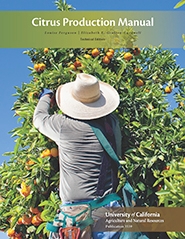One of the major challenges facing citrus integrated pest management (IPM) in California is the recent, sharp increase in the acreage of mandarins being planted. The current citrus IPM guidelines have been established from years of experiments and experience in oranges, with no specific guidelines for mandarins. In the absence of research into key arthropod pest effects in mandarins, the assumption that the pest management practices for oranges appropriately transfer for optimal production in mandarins has not been tested. We used a data mining or ‘ecoinformatics' approach in which we compiled and analyzed production records collected by growers and pest control advisors to gain an overview of direct pest densities and their relationships with fruit damage for 202 commercial groves, each surveyed for 1–10 yr in the main production region of California. Pest densities were different among four commonly grown species of citrus marketed as mandarins (Citrus reticulata, C. clementina, C. unshiu, and C. tangelo) compared with the standard Citrus sinensis sweet oranges, for fork-tailed bush katydids (Scudderia furcata Brunner von Wattenwyl [Orthoptera: Tettigoniidae]), and citrus thrips (Scirtothrips citri Moulton [Thysanoptera: Thripidae]). Citrus reticulata had notably low levels of fruit damage, suggesting they have natural resistance to direct pests, especially fork-tailed bush katydids. These results suggest that mandarin-specific research and recommendations would improve citrus IPM. More broadly, this is an example of how an ecoinformatics approach can serve as a complement to traditional experimental methods to raise new and unexpected hypotheses that expand our understanding of agricultural systems.
Read on:
